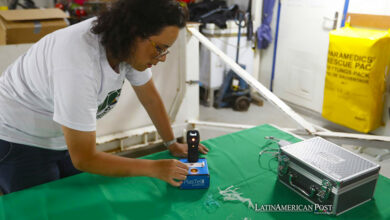Laura Becerra-Fajardo, a Pioneer Who Provides New Life Opportunities
Laura is an Electronics Engineer with experience in miniature medical devices, including biomedical implants. She is involved in electronic design, software development, and in vitro and in vivo evaluation.

The Woman Post | Carolina Rodríguez Monclou
Listen to this article
Currently, she participates in European research projects and is involved in technology transfer. For almost four years, she has worked as a postdoctoral researcher in Consolidator Grant awarded to Antoni Ivorra from European Research Commission and European H2020 research project EXTEND.
Working Hard for a Good Cause
Laura works on developing neuroprostheses so that people with mobility problems can regain normal body movement. Since 2017, she joined Pompeu Fabra University's team to restore mobility to Parkinson's, Hemiplegia, spinal cord injury, and foot drop patients.
Her Ph.D. dissertation title at this institution is: "Micro controlled injectable stimulators based on electronic rectification of high-frequency current bursts."
Years of Research
Although she graduated from The National University of Colombia as an electronic engineer, she became a biomedical engineer. Becerra works in research to develop neuroprosthetics. Her goal is to help paralyzed patients improve their mobility.
Laura is developing very thin and flexible implants. Through this, she creates a bridge between the central nervous system and the muscles to stimulate them.
In 2012 she finished her two-year master's degree in Biomedical Engineering at The University of Barcelona. At that time, her thesis project was "design of a Miniaturized Stimulator Based on AC Current Rectification for Neuroprosthesis."
Also read: ISABEL CRISTINA DE ÁVILA: AN UNSTOPPABLE CONVICTION IN THE TECH WORLD
As its name indicates, neuroprosthesis is for the nervous system instead of the lower or upper body. The purpose is for the muscles to receive the information that the brain sends to regain mobility.
How Does It Work?
According to SciShow, many prosthetics don't send information back to the brain about what they are doing. For this reason, neuroprosthesis is so revolutionary: because electronics and the nervous system are more than just similar in terms of their functions, they're also compatible with each other.
Engineers help users train the Brain-Computer Interface (BCI) to move their limbs with their minds, providing more natural control.
Pioneer in the Field of Neuroprosthetics
The entire development of this invention will take between 5 to 10 years because it requires many rigorous tests before being launched on the market as it is an implantable system. However, Laura is making her way as one of the pioneers in this technology.
During her doctoral thesis, Laura collected enough information to request funding to start her project. According to El Espectador, "the prostheses that Laura and the rest of the team develop are very thin. So much so that they can be injected into the human body and recharged by currents that come from a postable system, similar to a backpack, using the body as a conductor."
Her dream is to launch neuroprosthesis at reasonable prices. Although all the sacrifices she makes, Laura reveals that it is worth it if someday millions of people can benefit from her hard work. She's been so passionate about this topic that Laura has won many scholarships. The innovation of her work can have a significant impact on these patients.





